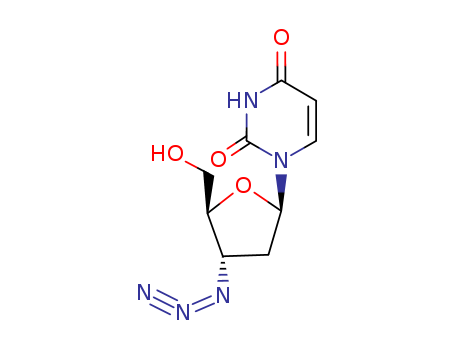10.1248/cpb.38.2597
The research focuses on the synthesis and evaluation of the anti-human Immunodeficiency Virus (HIV-1) activity of 3'-deoxy-3'-(triazol-1-yl)thymidines and 2',3'-dideoxy-3'-(triazol-1-yl)uridines, as well as the inhibition of reverse transcriptase by their 5'-triphosphates. The researchers hypothesized that the triazole nitrogen atoms could mimic the distorted azido group found in effective HIV inhibitors like AZT. They synthesized these compounds using cyclization of 5'-trityl derivatives of AZT and CS-87 with a-ketophosphorus ylides and acetylenic compounds, followed by deprotection of the 5'-trityl group. Key chemicals involved in the research include 3'-azido-3'-deoxythymidine (AZT), 3'-azido-2',3'-dideoxyuridine (CS-87), 1,2,3-triazole derivatives, and various reagents such as methyl propiolate and dimethyl acetylenedicarboxylate (DMAD). However, despite the successful synthesis of these compounds, no significant activity against HIV-1 was observed, and their 5'-triphosphates showed no appreciable inhibitory activity against reverse transcriptase enzymes from HIV-1 and Rauscher murine leukemia virus (RLV).
10.1021/jm00128a034
The first article details the synthesis and evaluation of several 2,5’-anhydro analogues of known antiviral compounds for their potential activity against HIV and Rauscher-Murine leukemia virus (R-MuLV). The study found that while the parent compounds like AZT were more active against HIV-1, the 2,5’-anhydro analogues demonstrated significant antiviral activity with reduced cytotoxicity. Notably, the 2,5’-anhydro derivative of AZT (compound 13) had a considerably lower cytotoxicity (TCID50 >100 μM) compared to AZT (TCID50 29 μM). The second article explores the quantitative structure-activity relationships (QSAR) of 68 5-(substituted benzyl)-2,4-diaminopyrimidines on dihydrofolate reductase (DHFR) from Lactobacillus casei and chicken liver. The study aims to design new trimethoprim-type antifolates with higher selectivity for bacterial DHFR. The QSAR analysis aligns well with stereographic models of the enzyme's active sites, and the findings are used to discuss the broader challenge of developing selective inhibitors for drug design.



